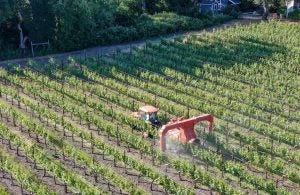State leaders in California have joined together to unveil a new roadmap of ambitious goals and actions to accelerate California’s systemwide plan to eliminate a list of “high-risk” pesticides by 2050.
The goal? The group (including the state’s departments of Food and Agriculture, Pesticide Regulation, and the California Environmental Protection Agency), plans to remove “toxic” Priority Pesticides from the system and encourage what the group calls more sustainable pest management to better protect the health of communities and the environment while supporting agriculture, food systems, and community well-being.
The 97-page Sustainable Pest Management Roadmap for California — released by the Department of Pesticide Regulation, the California Environmental Protection Agency, and the California Department of Food and Agriculture — charts a course for the state’s transition to sustainable pest management in agricultural and urban settings.
So, why all of the change? The Sustainable Pest Management Work Group was formed in response to both a recommendation from the state’s Chlorpyrifos Alternatives Work Group, and the governor’s, CalEPA’s and DPR’s interests to accelerate a holistic, systemwide approach to new pest management strategies.
“For decades, California has used pesticides to protect our crops, our cities, our homes, and our businesses from pests,” said Yana Garcia, California’s Secretary for Environmental Protection. “Exposure to harmful pesticides carries risks – to our health and to our environment — and these risks are disproportionately borne by communities already overburdened by pollution. If we truly want to build a healthy and safe California for all, we must phase out and replace the highest-risk pesticides, and the Sustainable Pest Management Roadmap is a bold, new plan to get us there.”

What are ‘Priority Pesticides’?
The number one goal or the “North Star” of the group is to eliminate the use of “Priority Pesticides” by 2050. But, the course outlined by the roadmap doesn’t list specific requirements for targeted chemicals or how they might be classified as a high priority — but organophosphates likely fall within the priority parameters. The state also released a list of Priority Chemicals for Biomonitoring California in July.
In a typo-riddled statement from the newly released document, here’s what they have to say:
“‘Priority Pesticides,’ which we are intentionally capitalizing, refer to pesticide products, active ingredients, and groups of related products within the context of specifc product uses or pest/ location use combinations that have been deemed to be of greatest concern and warrant heightened attention, planning, and support to expedite their replacement and eventual elimination The criteria for classifying pesticides as “Priority Pesticides” includes, but is not limited to, hazard and risk classifcations, availability of efective alternative products or practices, and special consideration of pest management situations that potentially cause severe or widespread adverse impacts The identifcation of these Priority Pesticides will be conducted by DPR under advisement of the multistakeholder Sustainable Pest Management Priorities Advisory Committee Priority Pesticides are a subset of high risk pesticides We defne “high risk” pesticides as active ingredients that are highly hazardous and/or formulations or uses that pose a likelihood of, or are known to cause, signifcant or widespread human and/or ecological impacts from their use.”
Who’s working on the roadmap?
“Despite California’s strict regulatory system and robust risk assessment process, there are still chemical tools in use that can cause harm to humans and the environment,” reads the roadmap. “Thirty-three leaders representing diverse interests were charged with aligning on a pathway to minimize reliance on the use of toxic pesticides …”
Out of the 33 members tasked with creating this change, there’s no doubt that the list of group members is diverse. Members of the working group include representatives for ag producers, the Almond Board of California, Bayer Crop Science, UC Cooperative Extension, organic producers, the School of Public Health, pest control advisors, and more.

Sustainable Pest Management
“Successfully transitioning to sustainable pest management requires collective action,” said DPR Director Julie Henderson. “The critical actions outlined in the roadmap include prioritizing prevention, coordinating state-level leadership, investing in building knowledge about sustainable pest management, improving the state’s registration and evaluation process to bring more sustainable alternatives to market and enhancing monitoring and statewide data collection to better inform actions.”
The Sustainable Pest Management approach is modeled after the University of California’s Integrated Pest Management Program. The plan is to prevent pests on the long-term through biological controls, habitat manipulation, modification of cultural practices, and the use of resistant varieties (cue GMOs?)
To achieve Sustainable Pest Management, California’s pest prevention exclusion and mitigation systems will need to be updated. The pesticide registration process will be reviewed to “prioritize and expedite safer, more sustainable alternative products to high-risk pesticides, and improve processes for evaluating currently registered pesticides.”
Finally, there will need to be enhanced monitoring and data collection — which means improving infrastructure and funding.
Public comments open
DPR opened a public comment period on the prioritization and implementation of next steps outlined in the Sustainable Pest Management Roadmap. The comment period will close on March 13, 2023. Comments can be sent to alternatives@cdpr.ca.gov or by mail to 1001 I Street, P.O. Box 4015, Sacramento, CA 95812. Comments received will be considered as part of the state-level coordination on implementing the recommendations in the Sustainable Pest Management Roadmap.

